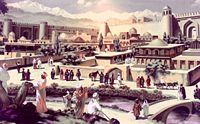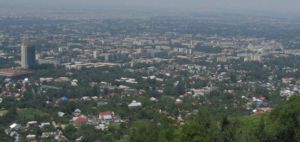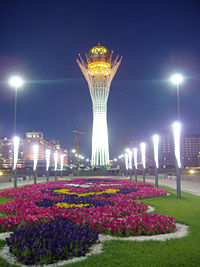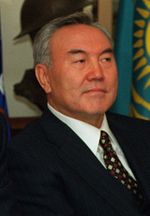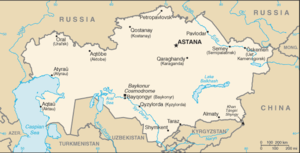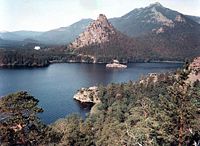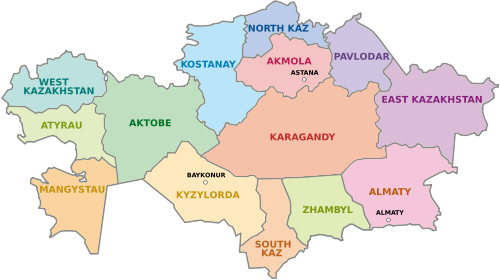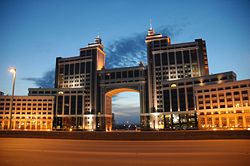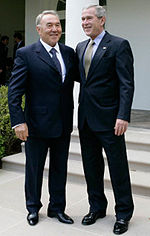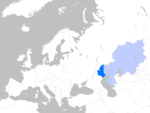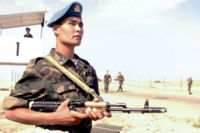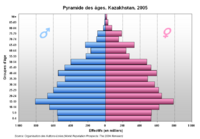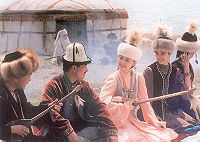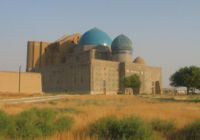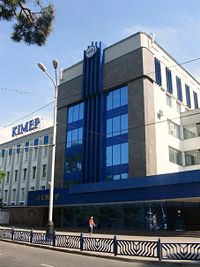Kazakhstan
2008/9 Schools Wikipedia Selection. Related subjects: Asia; Asian Countries
| Қазақстан Республикасы Qazaqstan Respublïkası Republic of Kazakhstan
|
||||||
|---|---|---|---|---|---|---|
|
||||||
| Anthem: Менің Қазақстаным ( Kazakh) Meniñ Qazaqstanım ( transcription) "My Kazakhstan" |
||||||
|
|
||||||
| Capital | Astana |
|||||
| Largest city | Almaty | |||||
| Official languages | Kazakh 1 Russian 2 |
|||||
| Demonym | Kazakhstani | |||||
| Government | Presidential republic | |||||
| - | President | Nursultan Nazarbayev | ||||
| - | Prime Minister | Karim Masimov | ||||
| Independence | from the Soviet Union | |||||
| - | 1st Khanate | 1361 as White Horde | ||||
| - | 2nd Khanate | 1428 as Uzbek Horde | ||||
| - | 3rd Khanate | 1465 as Kazakh Khanate | ||||
| - | Declared | December 16, 1991 | ||||
| - | Finalized | December 25, 1991 | ||||
| Area | ||||||
| - | Total | 2,724,900 km² ( 9th) 1,052,085 sq mi |
||||
| - | Water (%) | 1.7 | ||||
| Population | ||||||
| - | January 2006 estimate | 15,217,711 ( 62nd) | ||||
| - | 1999 census | 14,953,100 | ||||
| - | Density | 5.4/km² ( 215th) 14.0/sq mi |
||||
| GDP ( PPP) | 2007 estimate | |||||
| - | Total | 161,155$ billion ( 56th) | ||||
| - | Per capita | $10,658 ( 66th) | ||||
| Gini (2003) | 33.9 (medium) | |||||
| HDI (2007) | ▲ 0.794 (medium) ( 73rd) | |||||
| Currency | Tenge ( KZT) |
|||||
| Time zone | West/East ( UTC+5/+6) | |||||
| - | Summer ( DST) | not observed ( UTC+5/+6) | ||||
| Internet TLD | .kz | |||||
| Calling code | +7 | |||||
| 1 | The state language. | |||||
| 2 | The language of interethnic communication. | |||||
Kazakhstan, also spelled Kazakstan ( Kazakh: Қазақстан, Qazaqstan, IPA: [qɑzɑqˈstɑn]; Russian: Казахстан, Kazakhstán, Russian pronunciation: [kazəxˈstan]), officially the Republic of Kazakhstan, is a country in Central Asia and Europe. Ranked as the ninth largest country in the world as well as the world's largest landlocked country, it has a territory of 2,727,300 km² (greater than Western Europe). It is bordered by Russia, Kyrgyzstan, Turkmenistan, Uzbekistan and China. The country also borders on a significant part of the Caspian Sea.
Vast in size, the land in Kazakhstan is very diverse in types of terrain: flatlands, steppes, taigas, rock-canyons, hills, deltas, mountains, snow-capped mountains, and deserts. Kazakhstan has the 62nd largest population in the world, with a population density of less than 6 people per square kilometre (15 per sq. mi.).
For most of its history the territory of modern-day Kazakhstan has been inhabited by nomadic tribes. By the 16th century the Kazakhs emerged as a distinct group, divided into three hordes. The Russians began advancing into the Kazakh steppe in the 18th century, and by the mid-19th century all of Kazakhstan was part of the Russian Empire. Following the 1917 Russian Revolution, and subsequent civil war, the territory of Kazakhstan was reorganized several times before becoming the Kazakh Soviet Socialist Republic in 1936, a part of the USSR. During the 20th century, Kazakhstan was the site of major Soviet projects, including Khrushchev's Virgin Lands campaign, the Baikonur Cosmodrome, and the Semipalatinsk "Polygon", the USSR's primary nuclear weapon testing site.
Kazakhstan declared itself an independent country on December 16, 1991, the last Soviet republic to do so. Its communist-era leader, Nursultan Nazarbayev, became the country's new president. Since independence, Kazakhstan has pursued a balanced foreign policy and worked to develop its economy, especially its hydrocarbon industry. While the country's economic outlook is improving, President Nazarbayev maintains strict control over the country's politics. Several opposition leaders and journalists have been killed in recent years, and Western observers generally do not consider Kazakhstan's elections to be free and fair. Nevertheless, Kazakhstan's international prestige is building. It is now considered to be the dominant state in Central Asia. The country belongs to many international organizations, including the United Nations, NATO's Partnership for Peace, the Commonwealth of Independent States, and the Shanghai Cooperation Organization. In 2010, Kazakhstan will chair the Organization for Security and Cooperation in Europe. In 2011, it will form a customs union with Russia and Belarus.
Kazakhstan is ethnically and culturally diverse, in part due to mass deportations of many ethnic groups to the country during Stalin's rule. Kazakhs are the largest group, followed by Russians. Kazakhstan allows freedom of religion, and many different beliefs are represented in the country. Islam is the primary religion, followed by Orthodox Christianity. The official language is Kazakh, though Russian is still commonly used for everyday communication.
History
Kazakh Khanate
Kazakhstan has been inhabited since the Stone Age: the region's climate and terrain are best suited for nomads practising pastoralism. Historians believe that humans first domesticated the horse in the region's vast steppes. While ancient cities Taraz (Aulie-Ata) and Hazrat-e Turkestan had long served as important way-stations along the Silk Road connecting East and West, real political consolidation only began with the Mongol invasion of the early thirteenth century AD. Under the Mongol Empire, administrative districts were established, and these eventually came under the emergent Kazakh Khanate.
Throughout this period traditional nomadic life and a livestock-based economy continued to dominate the steppe. In the 15th century, a distinct Kazakh identity began to emerge among the Turkic tribes, a process which was consolidated by the mid-16th century with the appearance of a distinctive Kazakh language, culture, and economy. Nevertheless, the region was the focus of ever-increasing disputes between the native Kazakh emirs and the neighboring Persian-speaking peoples to the south. By the early 17th century, the Kazakh Khanate was struggling with the impact of tribal rivalries, which has effectively divided the population into the Great, Middle and Little (or Small) Hordes (jüz). Political disunion, tribal rivalries, and the diminishing importance of overland trade routes between East and West weakened the Kazakh Khanate.
During the 17th century Kazakhs fought Oirats, a federation of western Mongol tribes, among which the Dzungars were particularly aggressive. The beginning of the 18th century marked the zenith of the Kazakh Khanate. During this period the Little Horde participated in the 1723–1730 war against the Dzungars, following their "Great Disaster" invasion of Kazakh territories. Under leadership Abul Khair Khan the Kazakhs won major victories over the Dzungar at the Bulanty River, in 1726, and at the Battle of Anrakay in 1729. Ablai Khan participated in the most significant battles against the Dzungars from the 1720s to the 1750s, for which he was declared a "batyr" ("hero") by the people. Kazakhs were also a victims of constant raids carried out by the Volga Kalmyks.
Russian Empire
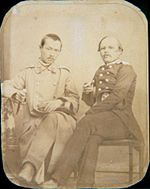
In the 19th century, the Russian Empire began to expand, and spread into Central Asia. The " Great Game" period is generally regarded as running from approximately 1813 to the Anglo-Russian Convention of 1907. The tsars effectively ruled over most of the territory belonging to what is now the Republic of Kazakhstan.
The Russian Empire introduced a system of administration and built military garrisons and barracks in its effort to establish a presence in Central Asia in the so-called "Great Game" between it and the United Kingdom. The first Russian outpost, Orsk, was built in 1735. Russia enforced the Russian language in all schools and governmental organizations. Russian efforts to impose its system aroused the extreme resentment by the Kazakh people, and by the 1860s, most Kazakhs resisted Russia's annexation largely because of the disruption it wrought upon the traditional nomadic lifestyle and livestock-based economy, and the associated hunger which was rapidly wiping out some Kazakh tribes. The Kazakh national movement, which began in the late 1800s, sought to preserve the native language and identity by resisting the attempts of the Russian Empire to assimilate and stifle them.
From the 1890s onwards ever-larger numbers of Slavic settlers began colonising the territory of present-day Kazakhstan, in particular the province of Semirechye. The number of settlers rose still further once the Trans-Aral Railway from Orenburg to Tashkent was completed in 1906, and the movement was overseen and encouraged by a specially created Migration Department (Переселенческое Управление) in St. Petersburg.
The competition for land and water which ensued between the Kazakhs and the newcomers caused great resentment against colonial rule during the final years of Tsarist Russia, with the most serious uprising, the Central Asian Revolt, occurring in 1916. The Kazakhs attacked Russian and Cossack villages, killing indiscriminately. The Russians' revenge was merciless. A military force drove 300,000 Kazakhs to flee into the mountains or to China. When approximately 80,000 of them returned the next year, many of them were slaughtered by Tsarist forces. During the 1921–22 famine, another million Kazakhs died from starvation.
Soviet Union
Although there was a brief period of autonomy ( Alash Autonomy) during the tumultuous period following the collapse of the Russian Empire, many uprisings were brutally suppressed, and the Kazakhs eventually succumbed to Soviet rule. In 1920, the area of present-day Kazakhstan became an autonomous republic within R.S.F.S.R..
Soviet repression of the traditional elite, along with forced collectivization in late 1920s–1930s, brought mass hunger and led to unrest. Between 1926 and 1939, the Kazakh population declined by 22%, due to starvation, violence and mass emigration. Today, the estimates suggest that the population of Kazakhstan would be closer to 20 million if there was no starvation or massacre of Kazakhs. During the 1930s, many renowned Kazakh writers, thinkers, poets, politicians and historians were slaughtered on Stalin's orders, both as part of the repression and as a methodical pattern of suppressing Kazakh identity and culture. Soviet rule took hold, and a communist apparatus steadily worked to fully integrate Kazakhstan into the Soviet system. In 1936 Kazakhstan became a Soviet republic. Kazakhstan experienced population inflows of millions exiled from other parts of the Soviet Union during the 1930s and 1940s; many of the deportation victims were deported to Siberia or Kazakhstan merely due to their ethnic heritage or beliefs, and were in many cases interned in some of the biggest Soviet labor camps. (See also: Population transfer in the Soviet Union, Involuntary settlements in the Soviet Union.) The Kazakh Soviet Socialist Republic (SSR) contributed five national divisions to the Soviet Union's World War II effort. In 1947, two years after the end of the war, the Semipalatinsk Test Site, the USSR's main nuclear weapon test site was founded near the city of Semey.
The period of World War II marked an increase in industrialization and increased mineral extraction in support of the war effort. At the time of Soviet leader Joseph Stalin's death, however, Kazakhstan still had an overwhelmingly agricultural-based economy. In 1953, Soviet leader Nikita Khrushchev initiated the ambitious " Virgin Lands" program to turn the traditional pasture lands of Kazakhstan into a major grain-producing region for the Soviet Union. The Virgin Lands policy brought mixed results. However, along with later modernizations under Soviet leader Leonid Brezhnev, it accelerated the development of the agricultural sector which remains the source of livelihood for a large percentage of Kazakhstan's population. By 1959, Kazakhs made up 30% of the population. Ethnic Russians accounted for 43%.
Growing tensions within Soviet society led to a demand for political and economic reforms, which came to a head in the 1980s. A factor that has contributed to this immensely was Lavrentii Beria's decision to test a nuclear bomb on the territory of Kazakh SSR in Semipalatinsk (also known as Semey) in 1949. This had a catastrophic ecological and biological effect which was felt generations later, and Kazakh anger toward the Soviet system has escalated. In December 1986, mass demonstrations by young ethnic Kazakhs, later called Jeltoksan riot, took place in Almaty to protest the replacement of the First Secretary of the Communist Party of the Kazakh SSR Dinmukhamed Konayev with Gennady Kolbin from the Russian SFSR. Governmental troops suppressed the unrest, several people were killed and many demonstrators were jailed. In the waning days of Soviet rule, discontent continued to grow and find expression under Soviet leader Mikhail Gorbachev's policy of glasnost.
Independence
Caught up in the groundswell of Soviet republics seeking greater autonomy, Kazakhstan declared its sovereignty as a republic within the Union of Soviet Socialist Republics in October 1990. Following the August 1991 aborted coup attempt in Moscow and the subsequent dissolution of the Soviet Union, Kazakhstan declared independence on December 16, 1991. It was the last of the Soviet republics to declare independence.
The years following independence have been marked by significant reforms to the Soviet-style economy and political monopoly on power. Under Nursultan Nazarbayev, who initially came to power in 1989 as the head of the Communist Party of Kazakhstan and was eventually elected President in 1991, Kazakhstan has made significant progress toward developing a market economy. The country has enjoyed significant economic growth since 2000, partly due to its large oil, gas, and mineral reserves.
Democracy, however, has not gained much ground since 1991. "In June 2007, Kazakhstan's parliament passed a law granting President Nursultan Nazarbayev lifetime powers and privileges, including access to future presidents, immunity from criminal prosecution, and influence over domestic and foreign policy. Critics say he has become a de facto "president for life." Over the course of his ten years in power, Nazarbayev has repeatedly censored the press through arbitrary use of "slander" laws, blocked access to opposition web sites ( 9 November 1999), banned the Wahhabi religious sect ( 5 September 1998), drawn criticism from Amnesty International for excessive executions following specious trials ( March 21, 1996) and harsh prison conditions ( 13 August 1996), and refused demands that the governors of Kazakhstan's 14 provinces be elected, rather than appointed by the president ( April 7, 2000)."
Politics
Political system
Kazakhstan is a presidential republic. The president is the head of state. The president also is the commander in chief of the armed forces and may veto legislation that has been passed by the Parliament. The prime minister chairs the Cabinet of Ministers and serves as Kazakhstan's head of government. There are three deputy prime ministers and 16 ministers in the Cabinet. Karim Masimov has served as the Prime Minister since 10 January 2007.
Kazakhstan has a bicameral Parliament, made up of the lower house (the Majilis) and upper house (the Senate). Single mandate districts popularly elect 67 seats in the Majilis; there also are ten members elected by party-list vote rather than by single mandate districts. The Senate has 39 members. Two senators are selected by each of the elected assemblies ( Maslikhats) of Kazakhstan's 16 principal administrative divisions (14 provinces, plus the cities of Astana and Almaty). The president appoints the remaining seven senators. Majilis deputies and the government both have the right of legislative initiative, though the government proposes most legislation considered by the Parliament.
Elections
Elections to the Majilis in September 2004 yielded a lower house dominated by the pro-government Otan party, headed by President Nazarbayev. Two other parties considered sympathetic to the president, including the agrarian-industrial bloc AIST and the Asar party, founded by President Nazarbayev's daughter, won most of the remaining seats. Opposition parties, which were officially registered and competed in the elections, won a single seat during elections that the Organization for Security and Cooperation in Europe said fell short of international standards.
In 1999, Kazakhstan applied for observer status at the Council of Europe Parliamentary Assembly. The official response of the Assembly was that Kazakhstan could apply for full membership, because it is partially located in Europe, but that they would not be granted any status whatsoever at the Council until their democracy and human rights records improved.
On December 4, 2005, Nursultan Nazarbayev was reelected in a landslide victory. The electoral commission announced that he had won over 90% of the vote. The Organization for Security and Cooperation in Europe (OSCE) concluded the election did not meet international standards despite some improvements in the administration of the election. Xinhua News Agency reported that observers from the People's Republic of China, responsible in overseeing 25 polling stations in Astana, found that voting in those polls was conducted in a "transparent and fair" manner. Furthermore, Western governments did not express much criticism.
On August 17, 2007, elections to the lower house of parliament were held with the ruling Nur-Otan coalition winning every seat with 88% of the vote. None of the opposition parties have reached the benchmark 7% level of the seats. This has led some in the local media to question the competence and charisma of the opposition party leaders. Opposition parties made accusations of serious irregularities in the election.
Kazakh Intelligence Services
Kazakhstan's National Security Committee (KNB) was established on 13 June 1992. It includes the Service of Internal Security, Military Counterintelligence, Border Guard, several Commando units, and Foreign Intelligence (Barlau). The latter is considered by many as the most important part of KNB. Its director is Major General Omirtai Bitimov.
Geography
With an area of 2.7 million square kilometers (1.05 million sq. mi), Kazakhstan is the ninth-largest country in the world and the largest landlocked country in the world. It is equivalent to the size of Western Europe. It shares borders of 6,846 kilometers (4,254 mi) with Russia, 2,203 kilometers (1,369 mi) with Uzbekistan, 1,533 kilometers (953 mi) with China, 1,051 kilometers (653 mi) with Kyrgyzstan, and 379 kilometers (235 mi) with Turkmenistan. Major cities include Astana, Almaty, Karagandy, Shymkent, Atyrau and Oskemen. While located primarily in Asia, a small portion of Kazakhstan is also located west of the Urals in Eastern Europe.
The terrain extends west to east from the Caspian Sea to the Altay Mountains and north to south from the plains of Western Siberia to the oases and deserts of Central Asia. The Kazakh Steppe(plain), with an area of around 804,500 square kilometres (310,600 sq. mi), occupies one-third of the country and is the world's largest dry steppe region. The steppe is characterized by large areas of grasslands and sandy regions. Important rivers and lakes include: the Aral Sea, Ili River, Irtysh River, Ishim River, Ural River, Syrdariya, Charyn River and gorge, Lake Balkhash, and Lake Zaysan.
The climate is continental, with hot summers and colder winters. Precipitation varies between arid and semi-arid conditions.
The Charyn Canyon is 150–300 metres deep and 80 kilometres long, cutting through the red sandstone plateau and stretching along the Charyn River gorge in northern Tian Shan ("Heavenly Mountains", 200 km east of Almaty) at . The steep canyon slopes, columns and arches rise to heights of 150–300 m. The inaccessibility of the canyon provided a safe haven for a rare ash tree that survived the Ice Age and is nowadays also grown in some other areas. Bigach crater is a Pliocene or Miocene impact asteroid crater, 8 kilometres (5 mi) in diameter and estimated at 5 ± 3 million years old at .
Provinces
Kazakhstan is divided into 14 provinces (облыстар). The provinces are subdivided into districts (аудандар).
|
Notes:
Each province is headed by an Akim (provincial governor) appointed by the president. Municipal Akims are appointed by province Akims. The Government of Kazakhstan transferred its capital from Almaty to Astana on December 10, 1997.
Economy
The government of Kazakhstan plans to double its Gross domestic product (GDP) by 2008 and triple it by 2015 as compared to 2000. GDP growth has been stable in the last five years, at a rate higher than 9%. Buoyed by high world crude oil prices, GDP growth figures were in 2000, 2001, 2002, 2003, 2004, and 2005: 9.8%, 13.2%, 9.5%, 9.2%, 9.4%, and 9.2%, respectively. Other major exports of Kazakhstan include wheat, textile, and livestock. Kazakhstan forecasts that it will become the world's leading exporter of uranium by the year 2010.
Kazakhstan's monetary policy is generally considered by outside observers to be well-managed. Its principal challenge since 2002 has been to manage strong foreign currency inflows without sparking inflation. Since that time, inflation has not been under control, registering at 6.6% in 2002, 6.8% in 2003, and 6.4% in 2004, higher than forecast levels of 5.3%-6.0%. In 2000 Kazakhstan became the first former Soviet republic to repay all of its debt to the International Monetary Fund (IMF), 7 years ahead of schedule. In March 2002, the U.S. Department of Commerce granted Kazakhstan market economy status under U.S. trade law. This change in status recognized substantive market economy reforms in the areas of currency convertibility, wage rate determination, openness to foreign investment, and government control over the means of production and allocation of resources.
In September 2002 Kazakhstan became the first country in the CIS to receive an investment-grade credit rating from a major international credit rating agency. As of late December 2003, Kazakhstan's gross foreign debt was about $22.9 billion. Total governmental debt was $4.2 billion. This amounts to 14% of GDP. There has been a noticeable reduction in the ratio of debt to GDP observed in past years; the ratio of total governmental debt to GDP in 2000 was 21.7%, in 2001 it was 17.5%, and in 2002 it was 15.4%.
The upturn in economic growth, combined with the results of earlier tax and financial sector reforms, has dramatically improved government finances from the 1999 budget deficit level of 3.5% of GDP to a deficit of 1.2% of GDP in 2003. Government revenues grew from 19.8% of GDP in 1999 to 22.6% of GDP in 2001, but decreased to 16.2% of GDP in 2003. In 2000, Kazakhstan adopted a new tax code in an effort to consolidate these gains. On November 29, 2003 the Law on Changes to Tax Code was adopted, which reduced tax rates. The value added tax fell from 16% to 15%, the social tax from 21% to 20%, and the personal income tax from 30% to 20%. (On July 7, 2006 the personal income tax was reduced even further to a flat rate of 5% for personal income in the form of dividends and 10% for other personal income.) Kazakhstan furthered its reforms by adopting a new land code on June 20, 2003, and a new customs code on April 5, 2003.
Energy is the leading economic sector. Production of crude oil and natural gas condensate in Kazakhstan amounted to 51.2 million tons in 2003, which was 8.6% more than in 2002. Kazakhstan raised oil and gas condensate exports to 44.3 million tons in 2003, 13% higher than in 2002. Gas production in Kazakhstan in 2003 amounted to 13.9 billion cubic meters (491 billion cu. ft), up 22.7% compared to 2002, including natural gas production of 7.3 billion cubic meters (258 billion cu. ft); Kazakhstan holds about 4 billion tons of proven recoverable oil reserves and 2,000 cubic kilometers (480 cu mi) of gas. Industry analysts believe that planned expansion of oil production, coupled with the development of new fields, will enable the country to produce as much as 3 million barrels (477,000 m³) per day by 2015, lifting Kazakhstan into the ranks of the world's top 10 oil-producing nations. Kazakhstan's 2003 oil exports were valued at more than $7 billion, representing 65% of overall exports and 24% of the GDP. Major oil and gas fields and their recoverable oil reserves are Tengiz with 7 billion barrels (1.1 km³); Karachaganak with 8 billion barrels (1.3 km³) and 1,350 km³ of natural gas); and Kashagan with 7 to 9 billion barrels (1.1 to 1.4 km³).
Kazakhstan instituted an ambitious pension reform program in 1998. As of January 1, 2005, the pension assets were about $4.1 billion. There are 16 saving pension funds in the republic. The State Accumulating Pension Fund, the only state-owned fund, could be privatized as early as 2006. The country's unified financial regulatory agency oversees and regulates the pension funds. The pension funds' growing demand for quality investment outlets triggered rapid development of the debt securities market. Pension fund capital is being invested almost exclusively in corporate and government bonds, including Government of Kazakhstan Eurobonds. The Kazakhstani banking system is developing rapidly. The banking system's capitalization now exceeds $1 billion. The National Bank has introduced deposit insurance in its campaign to strengthen the banking sector. Several major foreign banks have branches in Kazakhstan, including ABN AMRO, Citibank, and HSBC. Raiffeisen Zentralbank and UniCredit have both recently entered the Kazakhstan's financial services market through acquisitions and stakebuilding.
Foreign relations and armed forces
Kazakhstan has stable relationships with all of its neighbors. Kazakhstan is also a member of the United Nations, Organization for Security and Cooperation in Europe, Euro-Atlantic Partnership Council and Organization of the Islamic Conference (OIC). It is an active participant in the North Atlantic Treaty Organisation Partnership for Peace program. Kazakhstan is also a member of the Commonwealth of Independent States, the Economic Cooperation Organization and the Shanghai Cooperation Organization. The nations of Kazakhstan, Russia, Belarus, Kyrgyzstan and Tajikistan established the Eurasian Economic Community in 2000 to re-energize earlier efforts at harmonizing trade tariffs and the creation of a free trade zone under a customs union. On the December 1 of 2007, it was revealed that Kazakhstan has been chosen to chair OSCE for the year 2010.
Since independence in 1991, Kazakhstan has pursued what is known as the multidimensional foreign policy (многовекторная внешняя политика), seeking equally good relations with two large neighbors, Russia and China, and the United States and the West generally. The policy has yielded results in the oil and gas sector, where companies from the U.S., Russia, China, and Europe are present at all major fields, and in the multidimensional directions of oil export pipelines out of Kazakhstan. Kazakhstan also enjoys strong, and rapidly developing, political and economic ties with Turkey.
Additionally, Russia currently leases approximately 6,000 km² (2,300 mi²) of territory enclosing the Baikonur Cosmodrome space launch site in south central Kazakhstan, where the first man was launched in space as well as Soviet space shuttle Buran and the well-known space station Mir.
Most of Kazakhstan's military was inherited from the the Soviet Armed Forces' Turkestan Military District. These units became the core of Kazakhstan's new military which acquired all the units of the 40th Army (the former 32nd Army) and part of the 17th Army Corps, including 6 land force divisions, storage bases, the 14th and 35th air-landing brigades, 2 rocket brigades, 2 artillery regiments and a large amount of equipment which had been withdrawn from over the Urals after the signing of the Treaty on Conventional Armed Forces in Europe. The largest expansion of the Kazakhstan Army has been focused on armored units in recent years. Since 1990, armored units have expanded from 500, to and 1,613 in 2005.
The Kazakh air force is composed mostly of Soviet-era planes, including 40 MiG-29s, 33 MiG-31s, 25 Su-24s and Su-27. A small naval force is also maintained on the Caspian Sea.
Kazakhstan sent 29 military engineers to Iraq under Polish command to assist the US occupation in Iraq.
Demographics
The US Census Bureau International Database list the current population of Kazakhstan as 16,763,795, while United Nations sources such as the World Bank give a 2002 estimate of 14,794,830.
The ethnic Kazakhs represent 59.2% of the population and ethnic Russians 25.6%, with a rich array of other groups represented, including Tatars, Uzbeks, Bashkirs, Uyghurs and Ukrainians. Some minorities such as Russian Germans (esp. Volga Germans), Ukrainians and Russian political opponents of the regime had been deported to Kazakhstan in the 1930s and 1940s by Stalin; some of the bigger Soviet labor camps existed in the country. Significant Russian immigration also connected with Virgin Lands Campaign and Soviet space program during Khrushchev era. There is also a small but active Jewish community. Before 1991 there were one million Volga Germans in Kazakhstan; most of them emigrated to Germany following the breakup of the Soviet Union. Most members of the smaller Pontian Greek minority have emigrated to Greece.
Kazakhstan is a bilingual country: the Kazakh language, spoken by 64.4% of the population, has the status of the "state" language, while Russian, which is spoken by almost all Kazakhstanis, is declared the "official" language, and is used routinely in business.
The 1990s were marked by the emigration of many of the country's Russians and Volga Germans, a process that began in the 1970s; this was a major factor in giving the autochthonous Kazakhs a majority along with higher Kazakh birthrates and ethnic Kazakh immigration from the People's Republic of China, Mongolia, and Russia. In the early twenty first century, Kazakhstan has become one of the leading nations in international adoptions. This has recently sparked some criticism in the Parliament of Kazakhstan, due to the concerns about safety and treatment of the children abroad and the questions regarding the low level of population in Kazakhstan.
Kazakhs and Kazakhstanis (terminology)
The Kazakh term қазақстандықтар (Russian: казахстанцы) (Kazakhstanis) was coined to describe all citizens of Kazakhstan, including non-Kazakhs. The word "Kazakh" is generally used to refer to people of actual Kazakh descent (including those living in China, Afghanistan, Turkey, Uzbekistan and other countries).
The ethnonym Kazakh is derived from an ancient Turkic word "independent, a free spirit". It is the result of Kazakhs' nomadic horseback culture and is related to the term " cossack". The Avestan/ Old Persian (See Indo-European languages) word "stan" means "land" or "place of".
Religion
Islam is the largest religion in Kazakhstan, followed by Russian Orthodox Christianity.
By tradition the Kazaks are Sunni Muslims of the Hanafi school, and the Russians are Russian Orthodox. In 1994, some 47 percent of the population was Muslim, 44 percent was Russian Orthodox, and 2 percent was Protestant, mainly Baptist.
Based on a 2007 data of, The Embassy of the Republic of Kazakhstan in the UK, Islam was practiced by 57% of the population, Christianity 40% and other religions 3%.
The country has historically hosted a wide variety of ethnic groups with varying religions. Tolerance to other societies has become a part of the Kazakh culture. The foundation of an independent republic, following the disintegration of the USSR, has launched a great deal of changes in every aspect of people’s lives. Religiosity of the population, as an essential part of any cultural identity, has undergone dynamic transformations as well.
After decades of suppressed culture, the people were feeling a great need for exhibiting their ethnic identity – in part through religion. Quantitative research shows that for the first years after the establishment of the new laws, waiving any restrictions on religious beliefs and proclaiming full freedom of confessions, the country experienced a huge spike in religious activity of its citizens. Hundreds of mosques, synagogues, churches, and other religious structures were built in a matter of years. All represented religions benefited from increased number of members and facilities. Many confessions that were absent before independence made their way into the country, appealing to hundreds of people. The government supported this activity, and has done its best to provide equality among all religious organizations and their followers. In late 1990’s, however, a slight decline in religiosity occurred.
Radical religious organizations, despite a popular belief, are of little danger to the national security. The few organizations that were uncovered are being investigated thoroughly by the proper committee. Therefore, Kazakhstan has a very diverse, stable, and safe religious background – a truly exceptional occurrence.
However, some reported occurrences of persecution against Hare Krishnas and Jehovah's Witnesses for proselytizing has raised concern in the international community. Despite popular belief, the 'persecution' amounts to nothing more than legal action caused by questionable documentation related to the houses which were built by the groups.
Education
Education is universal and mandatory through to the secondary level and the adult literacy rate is 99.5%. Education consists of three main educational phases: primary education (forms 1–4), basic general education (forms 5–9) and senior level education (forms 10–11 or 12) divided into continued general education and professional education. (Primary education is preceded by one year of pre-school education.) These three levels of education can be followed in one institution or in different ones (e.g. primary school, then secondary school). Recently, several secondary schools, specialized schools, magnet schools, gymnasiums, lyceums, linguistic and technical gymnasiums, have been founded. Secondary professional education is offered in special professional or technical schools, lyceums or colleges and vocational schools.
At present, there are universities, academies, and institutes, conservatories, higher schools and higher colleges. There are three main levels: basic higher education that provides the fundamentals of the chosen field of study and leads to the award of the Bachelor's degree; specialized higher education after which students are awarded the Specialist's Diploma; and scientific-pedagogical higher education which leads to the Master's Degree. Postgraduate education leads to the Kandidat Nauk (Candidate of Sciences) and the Doctor of Sciences. With the adoption of the Laws on Education and on Higher Education, a private sector has been established and several private institutions have been licensed.
The Ministry of Education of Kazakhstan runs a highly successful Bolashak scholarship, which is annually awarded to approximately three hundred applicants. The scholarship funds their education in institutions abroad, including the prestigious Oxford and Ivy League universities. The terms of the program include mandatory return to Kazakhstan for at least five years of employment.



